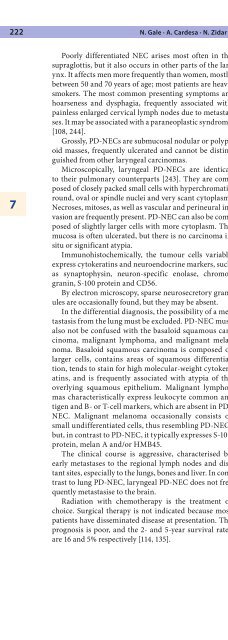Pathology of the Head and Neck
Pathology of the Head and Neck
Pathology of the Head and Neck
- No tags were found...
You also want an ePaper? Increase the reach of your titles
YUMPU automatically turns print PDFs into web optimized ePapers that Google loves.
222 N. Gale · A. Cardesa · N. Zidar7Poorly differentiated NEC arises most <strong>of</strong>ten in <strong>the</strong>supraglottis, but it also occurs in o<strong>the</strong>r parts <strong>of</strong> <strong>the</strong> larynx.It affects men more frequently than women, mostlybetween 50 <strong>and</strong> 70 years <strong>of</strong> age; most patients are heavysmokers. The most common presenting symptoms arehoarseness <strong>and</strong> dysphagia, frequently associated withpainless enlarged cervical lymph nodes due to metastases.It may be associated with a paraneoplastic syndrome[108, 244].Grossly, PD-NECs are submucosal nodular or polypoidmasses, frequently ulcerated <strong>and</strong> cannot be distinguishedfrom o<strong>the</strong>r laryngeal carcinomas.Microscopically, laryngeal PD-NECs are identicalto <strong>the</strong>ir pulmonary counterparts [243]. They are composed<strong>of</strong> closely packed small cells with hyperchromaticround, oval or spindle nuclei <strong>and</strong> very scant cytoplasm.Necroses, mitoses, as well as vascular <strong>and</strong> perineural invasionare frequently present. PD-NEC can also be composed<strong>of</strong> slightly larger cells with more cytoplasm. Themucosa is <strong>of</strong>ten ulcerated, but <strong>the</strong>re is no carcinoma insitu or significant atypia.Immunohistochemically, <strong>the</strong> tumour cells variablyexpress cytokeratins <strong>and</strong> neuroendocrine markers, suchas synaptophysin, neuron-specific enolase, chromogranin,S-100 protein <strong>and</strong> CD56.By electron microscopy, sparse neurosecretory granulesare occasionally found, but <strong>the</strong>y may be absent.In <strong>the</strong> differential diagnosis, <strong>the</strong> possibility <strong>of</strong> a metastasisfrom <strong>the</strong> lung must be excluded. PD-NEC mustalso not be confused with <strong>the</strong> basaloid squamous carcinoma,malignant lymphoma, <strong>and</strong> malignant melanoma.Basaloid squamous carcinoma is composed <strong>of</strong>larger cells, contains areas <strong>of</strong> squamous differentiation,tends to stain for high molecular-weight cytokeratins,<strong>and</strong> is frequently associated with atypia <strong>of</strong> <strong>the</strong>overlying squamous epi<strong>the</strong>lium. Malignant lymphomascharacteristically express leukocyte common antigen<strong>and</strong> B- or T-cell markers, which are absent in PD-NEC. Malignant melanoma occasionally consists <strong>of</strong>small undifferentiated cells, thus resembling PD-NEC,but, in contrast to PD-NEC, it typically expresses S-100protein, melan A <strong>and</strong>/or HMB45.The clinical course is aggressive, characterised byearly metastases to <strong>the</strong> regional lymph nodes <strong>and</strong> distantsites, especially to <strong>the</strong> lungs, bones <strong>and</strong> liver. In contrastto lung PD-NEC, laryngeal PD-NEC does not frequentlymetastasise to <strong>the</strong> brain.Radiation with chemo<strong>the</strong>rapy is <strong>the</strong> treatment <strong>of</strong>choice. Surgical <strong>the</strong>rapy is not indicated because mostpatients have disseminated disease at presentation. Theprognosis is poor, <strong>and</strong> <strong>the</strong> 2- <strong>and</strong> 5-year survival ratesare 16 <strong>and</strong> 5% respectively [114, 135].7.7.4 AdenocarcinomaIn spite <strong>of</strong> ra<strong>the</strong>r prominent salivary gl<strong>and</strong> tissue in <strong>the</strong>supraglottic <strong>and</strong> subglottic larynx, laryngeal adenocarcinomais rare, accounting for 1% <strong>of</strong> all laryngealneoplasms [3, 25, 347]. The majority <strong>of</strong> laryngeal adenocarcinomasare <strong>of</strong> <strong>the</strong> salivary gl<strong>and</strong> type. The mostcommon types are adenoid cystic carcinoma <strong>and</strong> mucoepidermoidcarcinoma. Rare examples <strong>of</strong> o<strong>the</strong>r types <strong>of</strong>adenocarcinoma have been also described in <strong>the</strong> larynx,such as acinic cell carcinoma [306], clear cell carcinoma[262], malignant myoepi<strong>the</strong>lioma [168], epi<strong>the</strong>lial-myoepi<strong>the</strong>lialcarcinoma [240], salivary duct carcinoma[109], etc.The aetiology is unknown, although exposure to asbestosor lead, alcohol abuse, viral infections, ionisingradiation <strong>and</strong> genetic risk factors have been implicatedas possible aetiologic factors [221].7.7.4.1 Adenoid Cystic CarcinomaICD-O:8200/3In contrast to o<strong>the</strong>r laryngeal carcinomas, adenoidcystic carcinoma (ACC) occurs at a younger age, withno gender predominance, <strong>and</strong> is more common in <strong>the</strong>subglottis [348]. Symptoms are similar to those <strong>of</strong> o<strong>the</strong>rtumours in <strong>the</strong> same localisation. In addition, pain isfrequently present, probably because <strong>of</strong> <strong>the</strong> tendency <strong>of</strong>ACC towards perineural invasion.Macroscopically, <strong>the</strong> tumour usually grows as a submucosalmass, covered by normal mucosa.The microscopic features <strong>of</strong> laryngeal ACC are <strong>the</strong>same as in o<strong>the</strong>r locations.Laryngeal ACC is characterised by a slowly progressivecourse, with a high incidence <strong>of</strong> local recurrence,long survival <strong>and</strong> a low cure rate. ACC has a tendencytowards haematogenic spread, mostly to <strong>the</strong> lungs<strong>and</strong> less frequently to <strong>the</strong> bones, liver <strong>and</strong> o<strong>the</strong>r organs[86, 348]. It does not usually metastasise to <strong>the</strong> regionallymph nodes.The treatment <strong>of</strong> choice is complete surgical excision.The 5-year survival rate is 30% [221, 347].7.7.4.2 Mucoepidermoid CarcinomaICD-O:8430/3Mucoepidermoid carcinoma (MEC) occurs at all ages,even in childhood, but it usually presents in <strong>the</strong> 6th <strong>and</strong>7th decades, predominantly in males. The majority occursin <strong>the</strong> supraglottis, but it has also been described in<strong>the</strong> glottis <strong>and</strong> subglottis, as well as in <strong>the</strong> hypopharynx[221, 335]. The clinical picture correlates with <strong>the</strong> localisation<strong>and</strong> size <strong>of</strong> <strong>the</strong> tumour.








